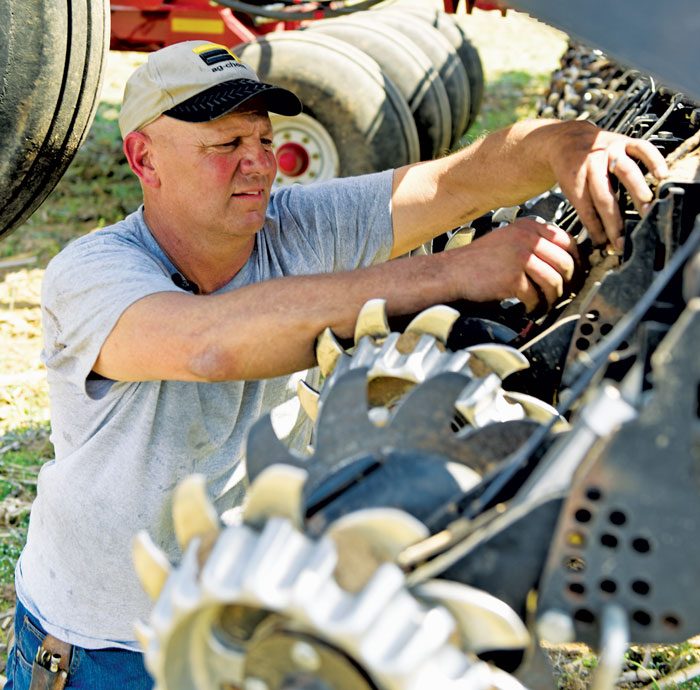Veteran farmers Jim Leverich of Sparta, Wis., and Keith Wendte of Effingham, Ill., are two early adopters of precision technology.
Leverich remembers using Ag Leader’s groundbreaking Yield Monitor 2000 in 1992, while Wendte recalls entering the precision arena around the same time with yield maps, GPS and grid soil sampling.
Leverich, a no-till innovator and educator with over 35 years of practical farming and on-farm research experience, and Wendte, a retired OEM engineer who manages data collection and analysis for his family’s 7,000-acre farm remotely from his home, shared their unique perspective at the 2023 Precision Farming Dealer Summit in St. Louis, Mo. Here are some highlights from the discussion.
What cutting-edge farm equipment technology is giving you the most advantage right now?
Leverich: The biggest advantage precision ag provides me, and most farmers, is the opportunity to measure and manage inputs, and figure out where they’re making money. I don’t think a lot of farmers are doing it yet, but once dealers figure out how to get them prepared so they can use this new technology, farmers can learn a lot about their operation every year.
RTK has been my best investment. You can try and make a corn planter perform in no-till with a good down force system, but you’re never planting in a good zone without RTK. The same applies to fertilizer application. We’re able to apply anhydrous the same day we’re planting without worrying about it because we can use RTK on both tractors. Once you learn how to use it, RTK is the technology that pays the most.
Wendte: The latest thing we’ve used on our farm is drone technology. We grow winter wheat, and we’re trying to apply fertilizer, insecticide and herbicide in the spring. Quite often it doesn’t work with a machine because it’s too wet. The drone gives us the ability to apply our nutrients to the crop when needed the most. It also allows us to lay out our check plots so we can check to see how well the inputs are performing.
“I think more dealers should host instruction courses for farmers…”
GPS is also very valuable in our operation. We do a lot of surface drainage, and it’s very important to have accurate topographical maps. That kind of technology has improved year after year. When we first started, we had correction signals from the Coast Guard, then came along RTK, and now we have DigiFarm. Some of our fields are over 30 miles away, and RTK doesn’t work more than 8 miles away. DigiFarm uses cellular modems and satellites to get the correction signal, which enables us to get accurate elevation maps on fields located a long distance from the farm without having to set up a remote correction signal.
As far as newer technologies go, I would like to see more work done on the development of on-the-go soil and tissue testing, so we wouldn’t have to gather samples and send them to the lab.
What’s the biggest challenge when it comes to adopting precision technologies on your farm?
Leverich: I have several different platforms. I have a Case IH 700 monitor, an Ag Leader monitor and a Fendt monitor. The biggest challenge is getting the RTK signal to all the monitors. When we switch tractors, it’s challenging to make sure they don’t all use the same measure points to shut off our seeding and spray nozzles.
Wendte: I do a lot of data analysis on the plots on our farm and have to manage so many different data formats. Even if you have the same equipment, it seems like there’s always something that’s changing. It doesn’t matter whether it’s AGCO or Deere, we have several short line pieces of equipment that we use to spread fertilizer, and it seems like everyone has a different format. It’s a pain having to set up the devices on the machines and also when it comes time to import the different formats. It’s just kind of a nightmare.
What’s something precision dealers can improve on?
Leverich: I used to be an extension educator, so I did a lot teaching. I think more dealers should host similar instruction courses for farmers. We could come to school in the winter and learn how to implement some of this new technology on our farms.
Wendte: I’d actually like to take it one step higher than that — I think many of the dealers we work with are not fully trained on precision technology. I think they could use a little education themselves. And once they get familiar with a new product then they can pass that knowledge down to the growers. I think we could resolve a lot of the day-to-day issues just by having more training.

“Even though I live over 200 miles away, fulfilling my responsibilities is not a problem,” says Effingham, Ill., farmer Keith Wendte. “With email, data cloud storage and telematics, gathering and analyzing data is fairly easy.” Image: Keith Wendte
Leverich: I have a son who works for AGCO as a product specialist. A big portion of his work now is going out to provide dealer training on new technology because he can’t answer all the questions as they come in.
Wendte: I think precision dealers can also improve their support. When I’m in the field and something isn’t working, I’d like to be able to make a phone or zoom call, and use the technology that’s out there to get the machine going. Many times, when I call a support line, I’m on hold forever.
Do you see autonomy having a place on your farm within the next 5-10 years?
Leverich: I see it coming, but I’m not sure it will be here as fast as I originally thought. I could see the potential of having smaller tractors — maybe 3 pieces of equipment planting at the same time rather than 1 planter and being able to split that investment up over time. Then you could purchase new inputs or planters and tractors in smaller portions.
Wendte: I think it’s going to be a slow adoption rate for autonomy. When I think about our own farm, there are just too many things that can go wrong.
For example, we have a lot of trees along the borders of our fields. The first time a tree falls down, what’s the machine going to do when it sees a big limb? Is it going to stop? Is it going to require someone to come out and do something, or is it just going to go around it? There are just too many things that can go wrong, and I think until machines become more reliable, it’s going to be a while until autonomy really takes off.
What does the adoption rate for precision technology look like in your region, and what’s preventing more farmers from embracing it?
Leverich: The adoption rate is pretty high in our area, but the implementation of data management is a ways off. There are a lot of farmers who are collecting data and not doing anything with it. I see a great opportunity for agronomists. I think eventually they’ll be like your tax accountant. You’re going to hire them to come in, help manage your data and explain how to make sense of it.
Wendte: In our region, the adoption rate in general has been relatively low. But there are a couple technologies that have been adopted rapidly — auto guidance and row unit shutoff on planters. Both save a lot of money, stress and hours.
VRT has been slower to catch on. I’ve done a lot of VRT plots. The problem is you can’t determine what rate you should be planting until you know what the weather is going to be like. So, maybe the next technology that needs to be developed is the predictability of the weather and how much rainfall you’re going to get during the growing season.







